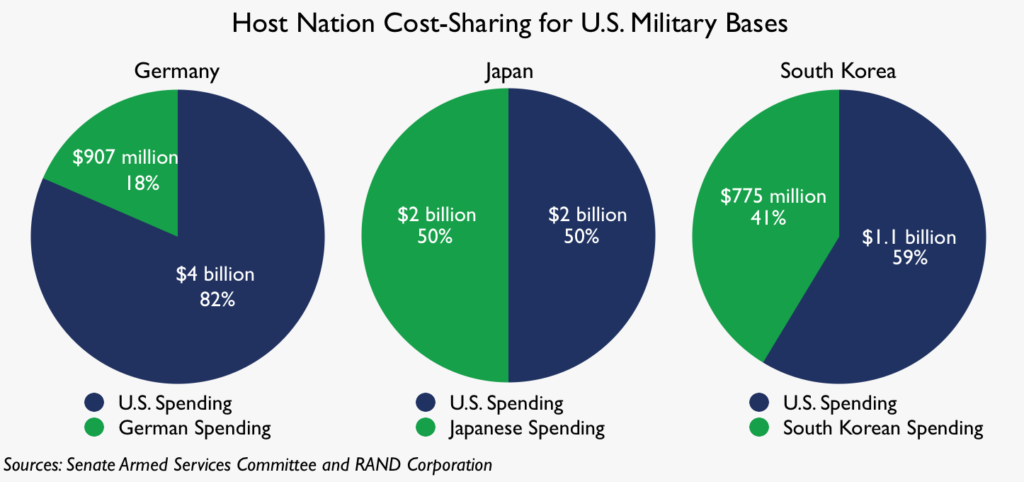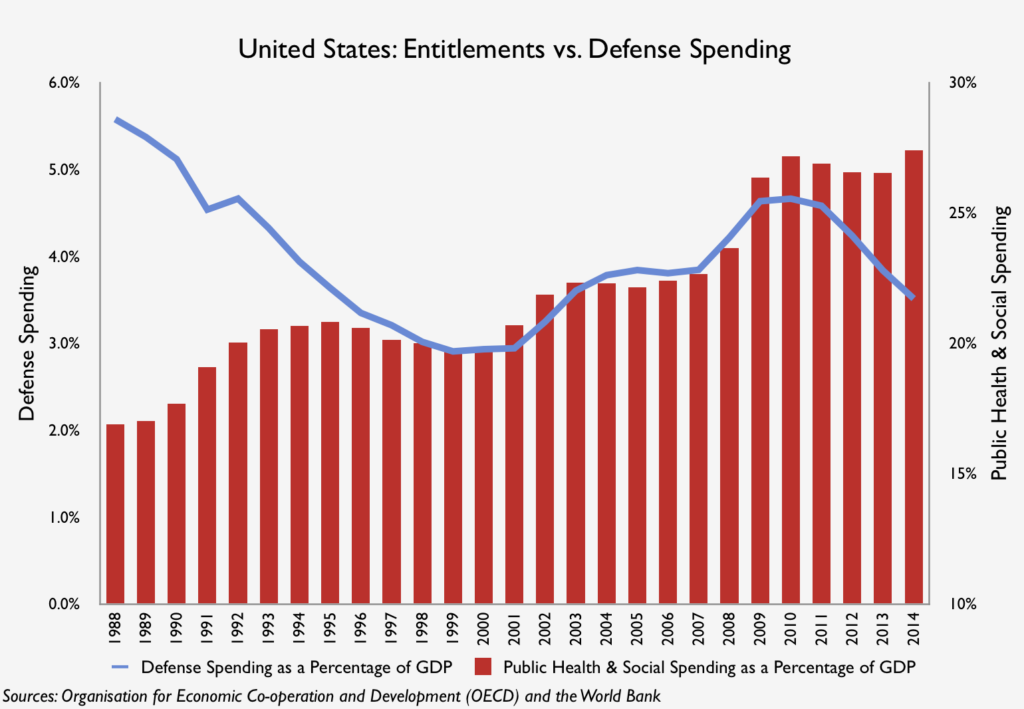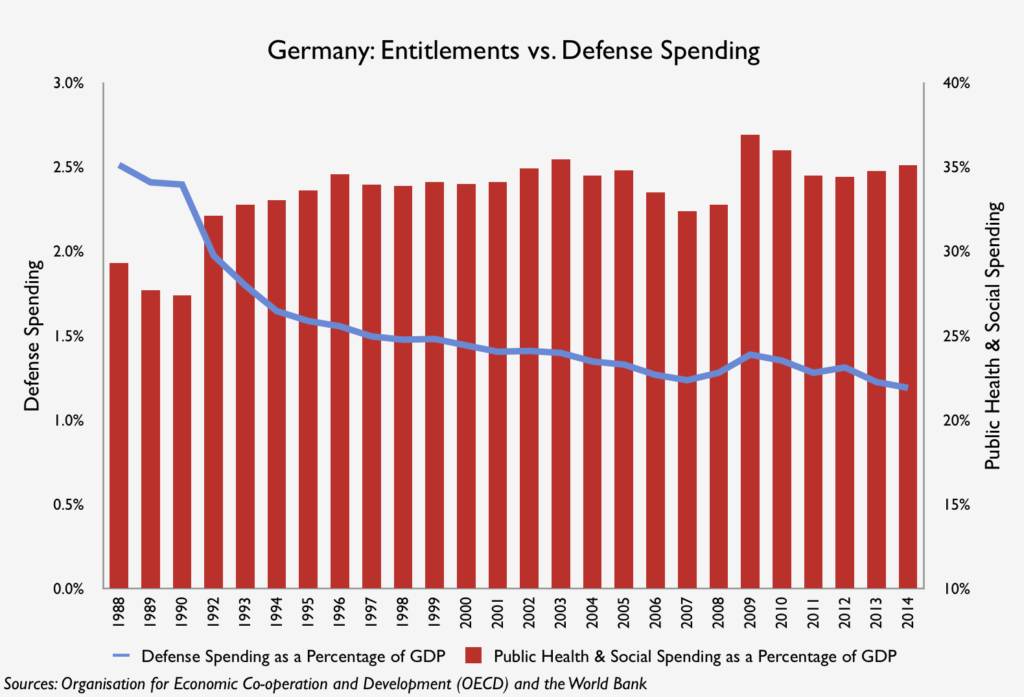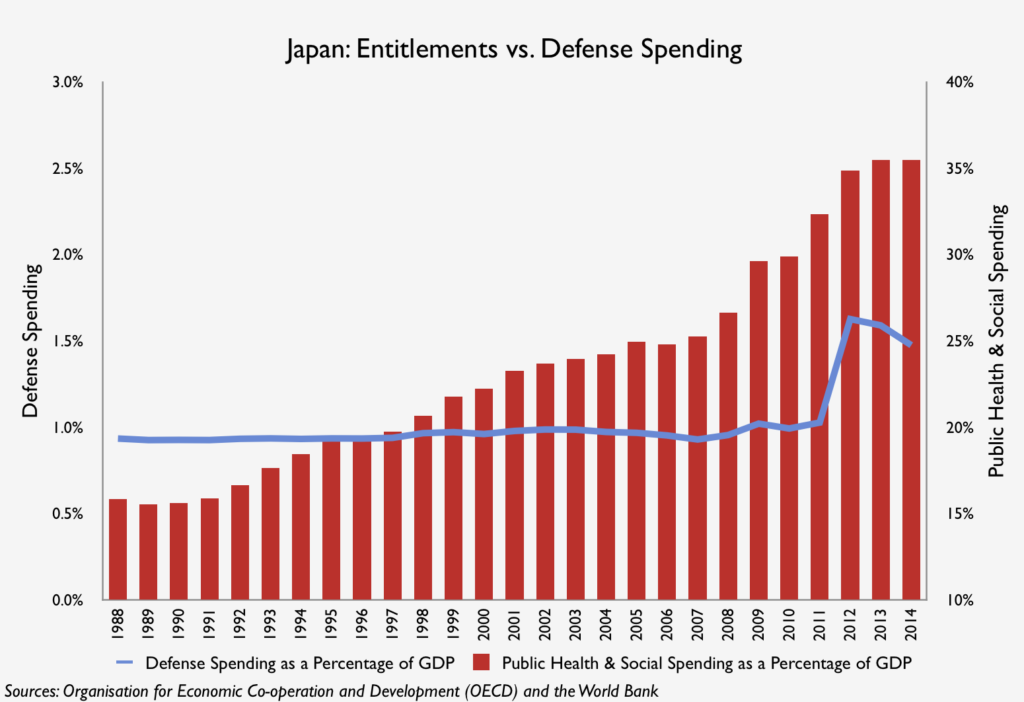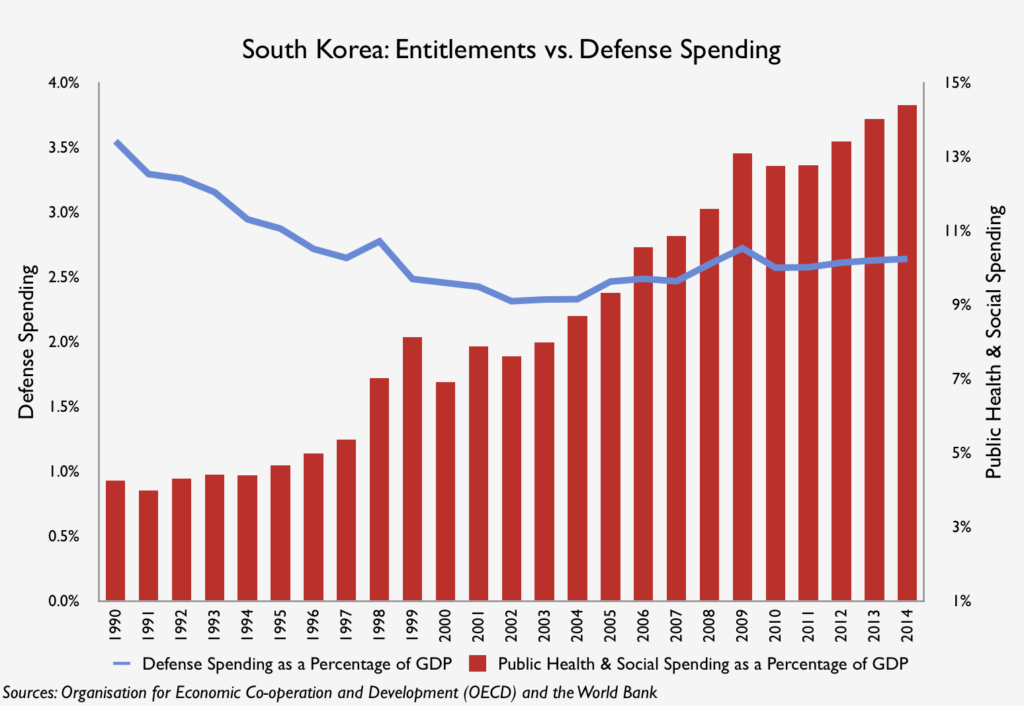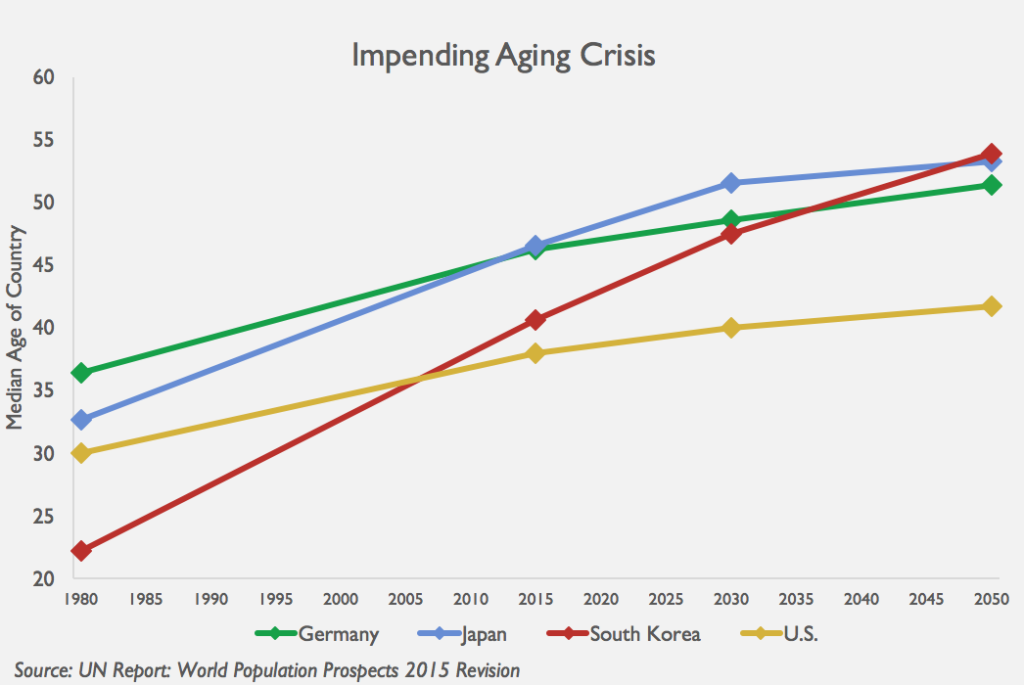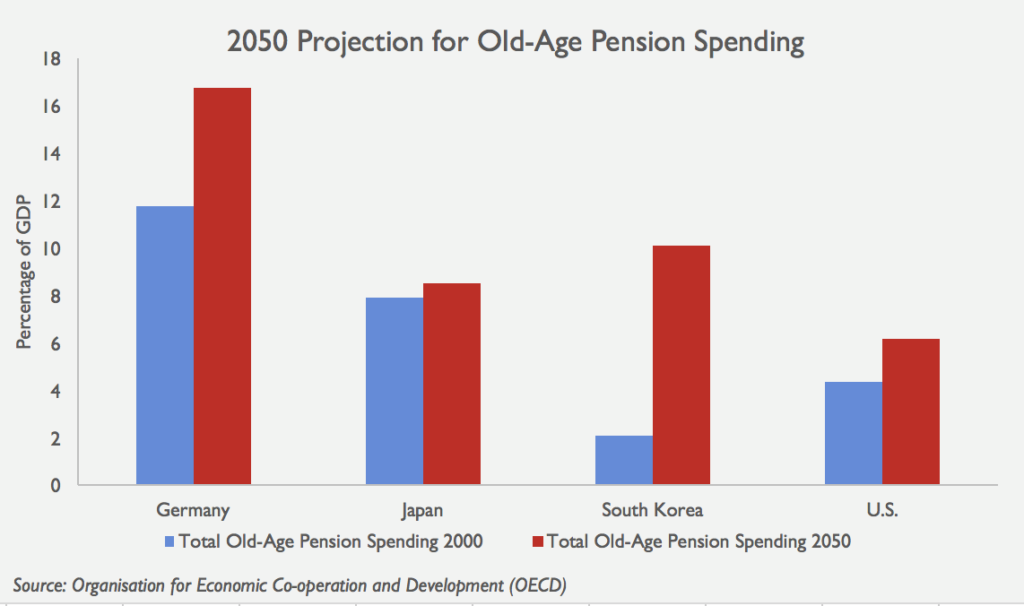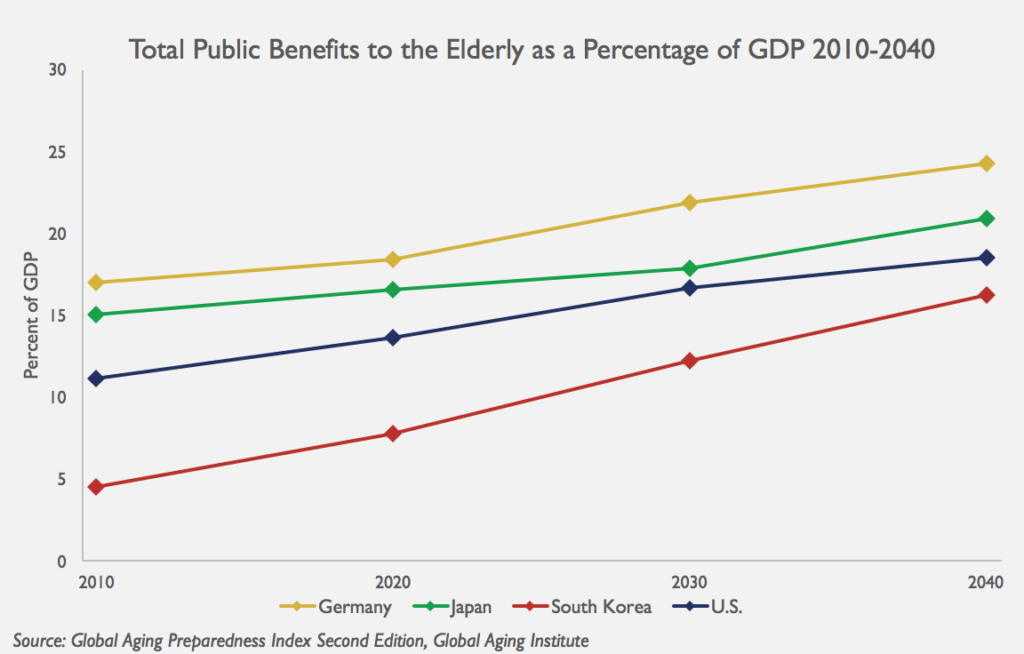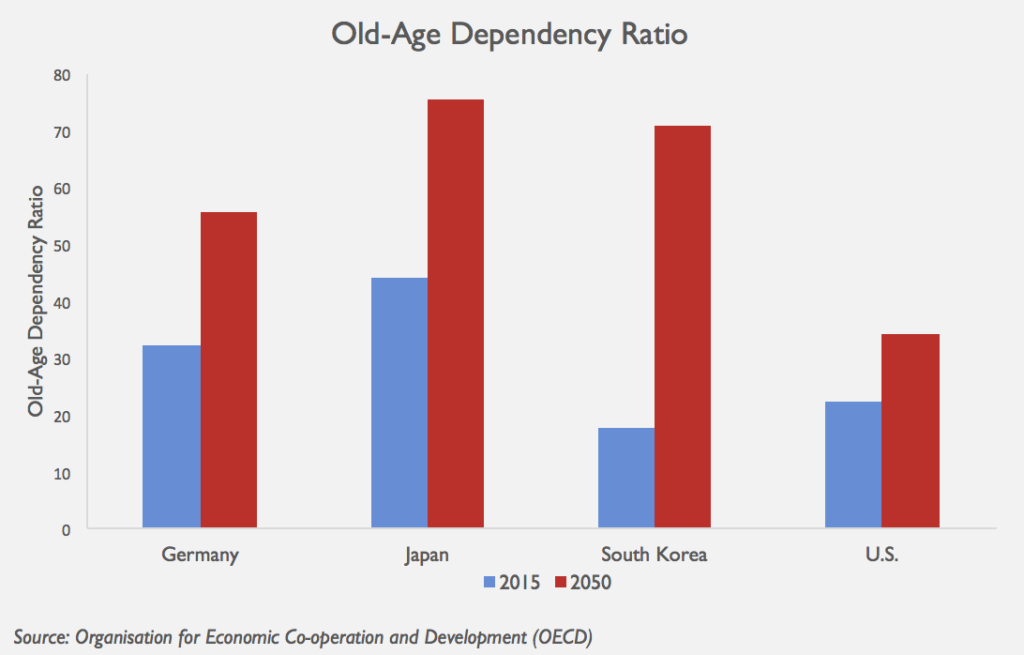Research
November 1, 2016
Burden-Sharing with Allies: Examining the Budgetary Realities
Summary
- U.S. allies around the world pay hundreds of millions of dollars per year to support American military bases—in some cases contributing half of the cost of these facilities.
- Important U.S. allies have recently announced plans to increase their overall defense spending, which requires tough trade-offs given rising entitlement spending in these countries.
- The aging crises that U.S. allies in Europe and Asia face will only aggravate the problem and make trade-offs even more severe.
Introduction
America’s global alliance system has for decades provided the foundation for peace, security, and prosperity. One important contribution of key allies in Europe and Asia is hosting U.S. military bases. The American military presence provides not only for the defense of our allies but also plays an integral role in securing U.S strategic interests around the world.
Republican presidential nominee Donald Trump has repeatedly questioned the economics of U.S. global security alliances, saying that the countries we protect must “pay up.” The conversation about burden-sharing when it comes to providing for the common defense is a valid one. This paper will examine the current cost-sharing structures for America’s permanent overseas military presence. It will also evaluate the domestic budgetary situations of key U.S. allies and how trade-offs between defense spending and entitlement spending might play out given varying demographic realities in each country.
Cost-Sharing for U.S. Military Bases
The three countries that host the greatest number of U.S. troops overseas are Germany, Japan, and South Korea. Over 45,000 active duty military personnel are stationed in Japan, Germany hosts around 35,000, and 25,000 are in South Korea. Together, these three nations host over 50 percent of all active duty U.S. troops stationed overseas.
The United States spends $10 billion annually on its permanent overseas military presence—just 2 percent of the total U.S. defense budget. (This figure does not include combat operations or military personnel costs.) Of this, $7 billion goes to support bases in Germany, Japan, and South Korea. With 70 percent of the funding for the overseas U.S. military presence supporting bases in these three countries, it is important to consider the cost-sharing structures in place with each country. Contributions from host nations can come in many forms, including: in-kind payments, military construction projects, and direct support.
Germany represents the highest cost for U.S. military presence, totaling nearly $5 billion per year. For its part, Germany contributes nearly $1 billion. While this only represents 18 percent of the overall cost, it is important to note that Germany’s payments to U.S. military facilities are almost entirely in-kind. These contributions are non-cash payments and include providing services or facilities that have monetary value.
U.S. burden-sharing agreements with Japan and South Korea, on the other hand, involve not only in-kind contributions but also direct support cash payments. These countries provide a much more significant share of U.S. base costs, with Japan contributing 50 percent and South Korea contributing 41 percent of the costs to support the American military presence in each country.
One major hidden “cost” to the host nations of U.S. military bases is the land on which the installations sit—often significant and strategically or commercially valuable territory. As the country with the most military bases overseas, the United States should acknowledge the value of the land itself.
The fact that these nations continue to uphold the Status of Forces Agreements with the United States, which provide the legal basis for stationing U.S. troops in their countries, indicates that the cumulative costs—including in-kind contributions, direct support payments, and the opportunity cost of the land—are outweighed by the benefit of American military presence and protection. For its part, the United States should not underestimate the contributions of these host nations, in whatever form, that enable the American projection of power around the world.
Cheaper than the Alternative
It is useful to consider the cost of global power projection, an integral aspect of U.S. national security, in the absence of overseas military bases. Should the United States simply decide that it is not getting a good deal for these military bases, the alternative (barring some dramatic restructuring of U.S. foreign policy) would be far costlier.
If the United States could not use its airfields in Germany for deployments to the war in Afghanistan, refueling aircraft would cost significantly more. This would only be more pronounced with any potential future deployments to the Middle East. In Asia, if the United States removed the base for its aircraft carrier battle group in Japan, it would need to replace it with several more carrier battle groups to continue the same Pacific presence—at a cost of nearly $50 billion. In South Korea, it is likely that the United States is actually saving money by stationing troops there rather than at home. U.S. military bases overseas are not only strategically valuable; they are cost effective as well.
Entitlement Spending vs. Defense Budgets
Since the end of the Cold War, nations around the world have seen stable or declining defense budgets while spending on entitlements (here defined as public health and social spending) has increased. In any country, competing budgetary pressures mean that trade-offs become central to the conversation about spending decisions. Assuming revenues remain constant, if any country wants to spend more on defense, it is going to come at the expense of domestic spending. Such is the case in the United States, and the situation is even more extreme in Germany, Japan, and South Korea, where social welfare programs constitute a greater or faster growing percentage of Gross Domestic Product (GDP). The following charts show 25 years of spending trends for entitlements compared with defense as a percentage of each country’s GDP.
United States
It should come as no surprise to anyone familiar with the U.S. budget that rapidly growing spending on entitlement programs like Social Security, Medicare, and Medicaid is responsible for the huge increase in federal spending. When other public health and social programs are taken into consideration, U.S. spending on entitlements grew about 10 percentage points as a share of GDP in 25 years. Meanwhile, defense has declined by several percentage points since the end of the Cold War despite increased military spending during the post-9/11 period when the United States was fighting two wars in Afghanistan and Iraq. Defense spending started to decline again with two important events in 2011: troop withdrawal from Iraq and the passage of the Budget Control Act, which placed a cap on defense spending.
Germany
German defense spending has steadily declined since the end of the Cold War. Chancellor Angela Merkel recently announced, however, that Germany would boost defense spending toward the NATO target of 2 percent of GDP. While German spending on entitlement programs has not grown as dramatically as in the United States, it is important to note that it has remained quite high as a percentage of GDP, hovering around 30 or 35 percent.
Japan
Entitlement spending in Japan grew dramatically over the last 25 years, from around 15 percent to around 35 percent of GDP. Historically, since the end of World War II, Japanese defense spending was capped at 1 percent of GDP. Since Prime Minister Abe took office in 2012, Japan has taken the unprecedented step of increasing its military budget—largely in response to the rising threat from China—by about half a percent.
South Korea
Of all of these countries, South Korea spends the least on entitlement programs as a percentage of GDP. (The country spends about 20 percent of its GDP on education and about 20 percent on economic affairs—around two or three times as much as the other countries considered here.) Still, the rise in entitlement spending in the last 25 years is noteworthy, increasing about 10 percentage points. Over the same period, defense spending has declined about 1 percentage point despite increasing tension on the Korean Peninsula with North Korea’s development of its missile and nuclear programs. In recent years, however, President Park announced a plan to increase South Korean defense spending in response to rising threats.
Rapidly Aging Populations
One challenge that Germany, Japan, and South Korea all face is an impending aging crisis. The United States does not face nearly the same problem, as birth rates remain relatively high compared to its allies in Europe and Asia. The following chart shows the median age in each country, projected out to 2050. In that year, the median age for Germany, Japan, and South Korea will be over 50—while in the United States it will be only 41. The world median age in 2050 is projected to be 36.
These aging trends will only aggravate the stress of entitlement programs on the budgets of countries like Germany, Japan, and South Korea. The effects will be most prominent on the public pension systems, but the impact will be much deeper. The Organisation for Economic Co-operation and Development (OECD) found that globally, “spending components that are sensitive to the age structure of the population represent between 40 and 60 percent of total public spending.” With that order of effect, it is difficult to project exactly how aging populations will impact national budgets, but it is clear that the stress on entitlement spending will be significant.
Increasing Cost of Benefits for the Elderly
One projection that is important to consider is rising pension spending. The following chart compares pension spending as a percentage of GDP for each country in 2000 compared with the projections for 2050.
The increases are dramatic—a 5 percentage point increase in Germany; 8 percentage points in South Korea. Meanwhile, the change in the United States will be less than 2 percent. It is worth noting that Japan is better off (a change of less than 1 percentage point) thanks in large part to the pension reform legislation it passed in 2004. The reforms included capping future increases in premium levels and automatically adjusting the payout levels according to demographic conditions.
There are similar trends with regard to benefits for the elderly as a whole—beyond just pensions, to include health benefits, long-term care services, disability benefits, and housing subsidies. The following chart shows the increase in public benefits for the elderly projected out to 2040.
In Germany and Japan, the combination of the aging population and a generous welfare state will push public benefits to the elderly past 20 percent of GDP by 2040. While South Korea is projected to spend less than the United States as a percentage of its GDP, its increase in spending is more significant—from under 5 percent in 2010 to over 15 percent in 2040.
Old-Age Dependency Ratio
One important factor that undergirds all of these trends in aging and benefits is the old-age dependency ratio. This is the ratio between the “dependent” population over the age of 65 relative to the working-age population (15-65 years old). In any country, the labor force pays for public benefits for the elderly, and so it is important that there is a large enough working population to support pensions and other public benefits for retirees. The following chart shows the dependency ratios in each country in 2015 compared with the projections for 2050.
The trends here are clear. Germany’s ratio nearly doubles to well over 50, while Japan and South Korea push dangerously high—above 70. (A ratio of 100 means that one elderly person is “dependent” upon each working age person.) The U.S. ratio, meanwhile, remains below 35. This demographic reality will only increase the budgetary stresses on these countries.
Conclusion
When Donald Trump says, “We protect so many different countries. We get nothing,” it is important to consider both the monetary and strategic aspects of that assertion. First, the fact is, host nations like Germany, Japan, and South Korea do pay for some of the cost of U.S. military facilities—often a significant portion. Through both in-kind contributions and direct cash payments, U.S. allies spend hundreds of millions of dollars every year to support American military bases in their countries. Second, security alliances go far beyond basic calculations of money and resources to considerations of strategy and interests. America’s overseas military presence is not just to protect allies around the world but also to secure U.S. strategic interests. In this regard, the benefit to the United States is incalculable—but it is safe to assume it is worth the 2 percent of the defense budget America currently spends to support its overseas military presence.
With revanchist Russian aggression and the renewed importance of the NATO alliance in Europe and the Chinese military build-up and North Korean nuclear ambition in Asia, the importance of the peacetime U.S. military presence in Germany, Japan, and South Korea has perhaps never been more clear. In this increasingly dangerous world, it is certainly fair to ask that U.S. allies spend more on defense. Germany, Japan, and South Korea have all recently announced plans to increase defense spending in response to rising threats in their regions. In this context, it is important to understand the domestic budgetary realities each country faces—particularly with regard to the stress that the aging crisis puts on entitlement spending. All budgetary questions ultimately come down to trade-offs, and in many ways these U.S. allies face tougher decisions than the United States purely because of demographic trends. What is true in America is true around the world: entitlement reform may be the key to not only a prosperous future but a secure and peaceful one as well.
AAF intern Alexander Bobroske contributed to this research.










